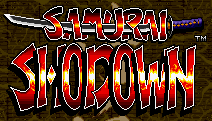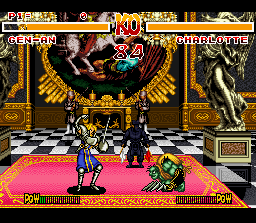 ... ...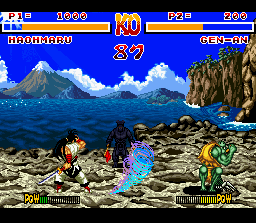
Samurai Shodown is, at one level, a Street Fighter 2 clone with a medieval Japanese setting, and, at another level, an elegant ballet of fist, feet, and swords. The gameplay is so involving and the atmosphere so engrossing, that I easily forgave the utter silliness of the dialogue and the anachronisms in the story. Although San Francisco didn't exist in the 1700's, this game made me think, well, maybe that's what it'd look like if it did.
That, I believe, is the type of thinking behind Samurai Shodown that makes it great: It doesn't sacrifice anything that would give it personality for realism. It is not a game content to be just another Street Fighter 2-wannabe. It answers the question of what would happen if real ninjas and samurai did their own version of a fighting game tournament: They slash each other repeatedly with swords, and only the traditional "chunk of life meter" gets lopped off instead of limbs or heads. Silly and highly unlikely, but in the name of great gameplay, who cares?
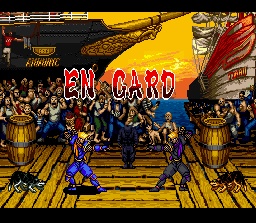 ... ...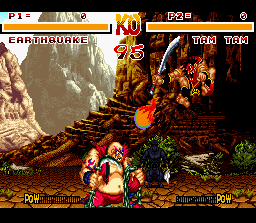
Only three of the game's twelve playable characters are actually true samurai, but they're all highly-skilled swordsmen (and women) brandishing unique weapons. These weapons are what gives the combat system its unique polish. Previous fighting games only occasionally had characters with weapons, and it was arguably just a graphical difference. But Samurai Shodown's swordplay drastically affects the game. As you might expect, blows delivered with swords do more damage than kicks and punches, and they can be used like a shield to block attacks. Thus, it is important to learn when and how to use your weapon, and to keep from losing it during the fight. Losing a weapon will put your character at a severe disadvantage until he/she can pick it up again, especially since many special moves cannot be performed without it. This, however, is knowledge that can be used against your opponent should you force him/her to lose his/her weapon instead.
Another innovation is the POW meter, which brings some balance to the gameplay. After taking so many hits, a character's POW meter will flash, during which time he/she will deal more damage with each successful strike. It is great for allowing you a chance to catch up if you're losing, or to scare you into playing more defensively when your opponent's meter is up.
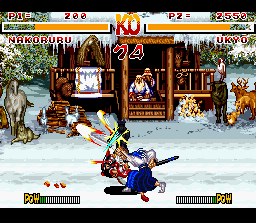 ... ...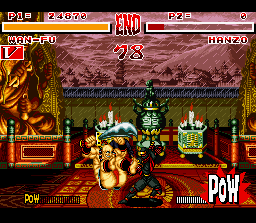
Samurai Shodown combines its weapons system with a standard fighting game engine based on learning and exploiting your enemy's patterns. This is where the game sticks more to the conventions, including the fighting game standard that the first character you face has the lowest AI, and then it gradually increases with each match. Also present is the rule within that standard that some characters are naturally more difficult to beat than others, and it will make little difference where they appear in the line-up. Earthquake, a 10-foot tall ninja wannabe with a weight problem, is a virtual punching bag, but Gen-an, a troll-like being with "Freddy Krueger" claws, has such an erratic fighting style that it can be difficult to deal with.
Even in sticking to some fighting game conventions, Samurai Shodown hurdles many that hold other games in the genre back. You cannot win fights by button-mashing, skill is a necessity. Nor can you just stand back and repeatedly throw projectiles because the damage they do isn't so great, and the computer will eventually start taking advantage of your moments of vulnerability. The game is completely fair: it is possible for every character to beat any other character on any difficulty setting, but devising specific strategies is often a requirement. While it's possible to sometimes apply the same strategy to multiple characters, that won't always be the case. It's easy to cheese through the game with Tam-Tam's hard sword slash, as the CPU has little defense against it. But if you're using Wan-Fu, you'll probably have to do something different for every fight. (Playing as Wan-Fu is one of the more interesting challenges in Samurai Shodown. Because his movement is so slow, and his projectile leaves him weaponless, it's necessary to plan your attacks a few moments ahead of time to be successful.) With the exception of a few special moves I could never get to work consistently, you'll be forced to use practically every kind of attack your character has.
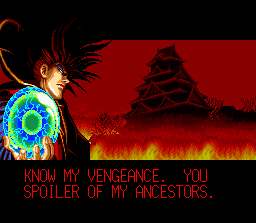 ... ...
Despite the nonsensical explanations in the manual, there is no dramatic purpose for this fighting, but there is a goal: A showdown with a highly eccentric final boss that's the epitome of a male anime character who looks, acts, and sounds female. (So much so, that it even fooled the makers of the legendarily bad Samurai Shodown animated movie.) This boss, Amakusa, appears between rounds to taunt you and topple buildings, and even if the character you're playing as doesn't seem to have a personal interest in beating him (most of them, except Hattori Hanzo, don't), at least you know that he's a madman capable of world-class destruction and must be stopped.
As goofy as Amakusa looks and sounds, he is one truly unique, challenging boss fight, and if you're anything like me, he'll hand your ass to you when you first get to him. His method of fighting is as exotic as his appearance, so learning to block and dodge his various attacks while exploiting what weaknesses he might have is crucial to beating him. He is faster and stronger than any character you've faced before, and he has certain moves that absolutely must be countered or dodged because they can take off over half your life meter and stun you in one hit. And he'll keep you moving because you don't want him to reappear on top of you when he teleports. Amakusa is arguably one of those bosses that's harder than the rest of the game combined, but there is a good learning curve leading up to him. By now you should know what your character is capable of doing; do it faster and be more precise.
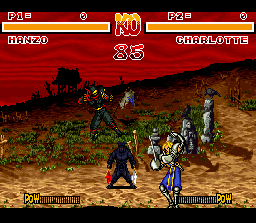 ... ...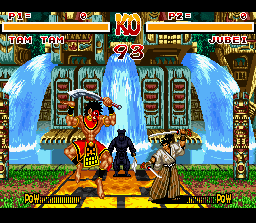
Samurai Shodown's is unique among SNES fighting games in its visual style and tone. For once, it's great to see ninjas, samurai, and kabuki warriors fighting on their own turf in their own time periods. It helps that many of the characters are loosely based on real-life historical people. The samurai Yagyu Jubei, the ninja Hattori Hanzo, and the priest Amakusa Shiro Tokisada all actually existed, although these interpretations are (obviously) somewhat inaccurate, and the revolution leader Charlotte seems inspired by "Joan of Arc". The backgrounds are bright and colorful, with a very convincing medieval Japanese style. My favorite stages are Hanzo's war-ravaged Japanese wasteland and Tam-Tam's Incan temple overflowing with great waterfalls. The character sprites are a bit small (smaller than they were in the arcade and NeoGeo versions and smaller than characters in most other SNES fighting games), but you do get nice large, colorful close-up drawings of them between rounds.
The music, which is mostly played on traditional Japanese instruments, is equally convincing for the atmosphere. Samurai Shodown's music tends to be more subtle than the fast-paced numbers more common to the genre. It often incoporates effects such as wind, howling wolves, chanting, and bird calls to give a sense of actually being surrounded by the wilderness you're fighting in, as opposed to just fighting on a generic game background. There are also a few traditionally more energetic pieces, such as Earthquake's heavy guitar theme.
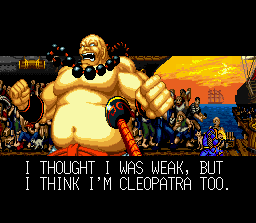 ... ...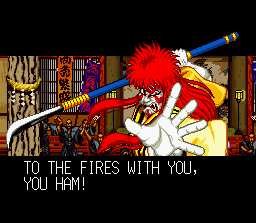
Despite how the game looks and sounds, the story and between-round trash-talk is about as goofy as fighting game dialogue ever gets. The endings for Charlotte and Ukyo are amongst the funniest things I've ever seen in a game, and I'm not sure it was intentional. Yet the game bubbles with personality, heart, and soul. It is, in this reviewer's opinion, sometimes better to have a little levity than to take everything too seriously, especially since the game contains enough anachronisms to destroy credibility for a serious plot, anyway. Samurai Shodown is more of an alternate universe, what-if scenario than an accurate portrayal of history (since the body of the real-life Amakusa was never found, what if he was just asleep all this time and awoke one day for revenge?). How else to explain an American ninja who fights with his trusty dog by his side, or a frustrated Kabuki actor who beats people up for being ignorant of Kaubki?
If there's any flaw in Samurai Shodown, it's that once you find a specific strategy for beating one fighter with another, chances are you can use that same strategy every time and it will still work. Only Amakusa seems to become wise to repeated use of a pattern and changes his own accordingly. I also feel that the game could have possibly been made more challenging overall had SNK been selective about how many characters you fight as opposed to making you fight all thirteen every time. But Samurai Shodown still rises above any shortcomings with a cast of fun characters, excellent play control, fast action, colorful settings, funny dialogue, and a great final boss fight. It's all rolled into an exercise in which knowing how to block and counter your opponent, and learning how best to exploit their moments of weakness, is much more important than memorizing any special move.
OVERALL
SCORE: 4/5
BACK
TO SUPER NES REVIEWS
BACK
TO MAIN PAGE
|
